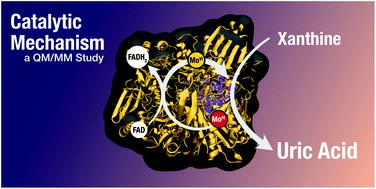当前位置:
X-MOL 学术
›
Inorg. Chem. Front.
›
论文详情
Our official English website, www.x-mol.net, welcomes your
feedback! (Note: you will need to create a separate account there.)
The complete catalytic mechanism of xanthine oxidase: a computational study
Inorganic Chemistry Frontiers ( IF 6.1 ) Pub Date : 2020-11-2 , DOI: 10.1039/d0qi01029d Pedro M. G. Ribeiro 1, 2, 3, 4, 5 , Henrique S. Fernandes 1, 2, 3, 4, 5 , Luísa B. Maia 6, 7, 8, 9, 10 , Sérgio F. Sousa 1, 2, 3, 4, 5 , José J. G. Moura 6, 7, 8, 9, 10 , Nuno M. F. S. A. Cerqueira 1, 2, 3, 4, 5
Inorganic Chemistry Frontiers ( IF 6.1 ) Pub Date : 2020-11-2 , DOI: 10.1039/d0qi01029d Pedro M. G. Ribeiro 1, 2, 3, 4, 5 , Henrique S. Fernandes 1, 2, 3, 4, 5 , Luísa B. Maia 6, 7, 8, 9, 10 , Sérgio F. Sousa 1, 2, 3, 4, 5 , José J. G. Moura 6, 7, 8, 9, 10 , Nuno M. F. S. A. Cerqueira 1, 2, 3, 4, 5
Affiliation

|
In this article, quantum mechanical/molecular mechanical (QM/MM) methods were used to study the full catalytic mechanism of xanthine oxidase (XO). XO catalyzes the conversion of xanthine (XAN) to uric acid (URC), in the presence of a molybdenum cofactor (Moco). The mechanism occurs through four reaction steps. Initially, the proton from the hydroxyl group of Moco passes to Glu1261 and the activated hydroxyl group makes a nucleophilic attack on XAN. Then, a hydride is transferred from the tetrahedral intermediate to the sulfur atom of the Moco, reducing Mo(VI) to Mo(IV). In the third step, one molecule of URC is formed through its protonation by Arg880. Once this reaction is complete, FAD is reduced to FADH2, oxidizing Mo(IV) to its initial oxidation state of Mo(VI). The enzymatic turnover is achieved with the reaction of one water molecule with the Moco. The rate-limiting step of the full catalytic mechanism is the hydride transfer that requires a free activation barrier of 16.9 kcal mol−1, which closely agrees with the experimental kcat value (18.3 s−1), which corresponds to approximately 15.7 kcal mol−1. This work also elucidates the key role played by Arg880 in the catalytic mechanism and the importance of Glu802 in the binding of the substrate. Both residues were previously shown to be important by mutagenesis studies, but their role was still not clearly understood. Additionally, it was observed that the presence of a tunnel of water molecules located close to Moco and Glu1261 is important for the enzymatic turnover. The determined transition state structures can now be used to help the development of transition-state analog inhibitors targeting XO.
中文翻译:

黄嘌呤氧化酶的完整催化机理:一个计算研究
在本文中,量子力学/分子力学(QM / MM)方法用于研究黄嘌呤氧化酶(XO)的完整催化机理。XO在钼辅助因子(Moco)的存在下催化黄嘌呤(XAN)向尿酸(URC)的转化。该机理通过四个反应步骤发生。最初,来自Moco羟基的质子传递到Glu1261,活化的羟基对XAN进行亲核攻击。然后,将氢化物从四面体中间体转移到Moco的硫原子上,从而将Mo(VI)还原为Mo(IV)。第三步,通过Arg880质子化形成一个URC分子。反应完成后,FAD还原为FADH 2,氧化Mo(IV)还原为Mo(VI)的初始氧化态。酶的转化通过一个水分子与Moco的反应实现。完全催化机理的限速步骤是氢化物转移,需要16.9 kcal mol -1的自由活化势垒,这与实验k cat值(18.3 s -1)非常吻合,相当于约15.7 kcal mol -1。这项工作还阐明了Arg880在催化机理中的关键作用以及Glu802在底物结合中的重要性。诱变研究先前已证明这两个残基都很重要,但仍不清楚其作用。此外,已观察到,靠近Moco和Glu1261的水分子隧道的存在对于酶促转换很重要。确定的过渡态结构现在可用于帮助开发靶向XO的过渡态类似物抑制剂。
更新日期:2020-12-17
中文翻译:

黄嘌呤氧化酶的完整催化机理:一个计算研究
在本文中,量子力学/分子力学(QM / MM)方法用于研究黄嘌呤氧化酶(XO)的完整催化机理。XO在钼辅助因子(Moco)的存在下催化黄嘌呤(XAN)向尿酸(URC)的转化。该机理通过四个反应步骤发生。最初,来自Moco羟基的质子传递到Glu1261,活化的羟基对XAN进行亲核攻击。然后,将氢化物从四面体中间体转移到Moco的硫原子上,从而将Mo(VI)还原为Mo(IV)。第三步,通过Arg880质子化形成一个URC分子。反应完成后,FAD还原为FADH 2,氧化Mo(IV)还原为Mo(VI)的初始氧化态。酶的转化通过一个水分子与Moco的反应实现。完全催化机理的限速步骤是氢化物转移,需要16.9 kcal mol -1的自由活化势垒,这与实验k cat值(18.3 s -1)非常吻合,相当于约15.7 kcal mol -1。这项工作还阐明了Arg880在催化机理中的关键作用以及Glu802在底物结合中的重要性。诱变研究先前已证明这两个残基都很重要,但仍不清楚其作用。此外,已观察到,靠近Moco和Glu1261的水分子隧道的存在对于酶促转换很重要。确定的过渡态结构现在可用于帮助开发靶向XO的过渡态类似物抑制剂。










































 京公网安备 11010802027423号
京公网安备 11010802027423号